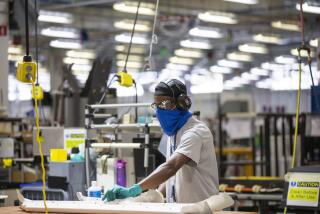Productivity Growth Rate Slowed in ’87
- Share via
WASHINGTON — Improvements in the nation’s efficiency in churning out goods and services slowed by almost half last year despite revised figures showing higher output in the fourth quarter, the government said Thursday.
The Labor Department said productivity among non-farm businesses responsible for three-fourths of the nation’s economic activity rose at an annual rate of 0.3% in the fourth quarter in contrast with a deterioration of 0.2% reported in preliminary figures last month.
The revisions raised the productivity improvement for the entire year to 0.9% from 0.8%, slightly more than half the 1.6% gain of 1986, despite the lowest hourly labor cost increases in more than four decades.
The efficiency improvements for the year were the smallest since 1982, when an economic recession depressed output so much that productivity actually declined 0.6% from 1981.
“Anything less than 1% is a disappointing number,” said Roger Brinner, an economist for Data Resources Inc. of Lexington, Mass. “It gives you very little room to buffer pay increases and not much leeway to improve the standard of living.”
Hours Worked Higher
The revised figures showed output of goods and services by non-farm businesses--which account for about three-fourths of the nation’s economic production--rising by an annual rate of 5.6% in the fourth quarter.
That is the greatest increase in nearly two years and compares to a rise of 5.1% in the preliminary figures before the gross national product was revised upward last week by the Commerce Department.
But in achieving that higher output, businesses increased the total hours worked by their employees by 5.3%.
Brinner said that reflects an increase of 3 million in the number of Americans with jobs last year and “gives you an indication that we may have an employment glut as well as an output glut” as seen in the high level of unsold inventories.
Still, the higher output helped reduce the annualized increase in labor costs associated with each unit of goods or services in the fourth quarter from 3.7% in the preliminary figures to 3.1% in the final ones, the Labor Department said.
Despite figures showing that hourly wages rose an average 2.8% for all of last year, workers still lost 0.8% of their income for each hour they worked after taking inflation into account, according to the revised statistics.
Dim Forecast
Manufacturing workers fared even worse. Their average wage increases of 1.3% dropped their purchasing power after inflation by 2.2% for the year.
Productivity in manufacturing improved 3.3% over the year--unchanged from the preliminary figures--with output up 4.3% on only a 1% increase in the number of hours worked.
That combination dropped the labor costs associated with each product coming out of the nation’s factories by an average 1.9% in 1987, the report said.
“Frankly, we don’t foresee much improvement in productivity this year,” said Donald Straszheim, chief economist for Merrill Lynch. “Productivity improvements require rapid growth, and we haven’t been experiencing much of that lately.”
More to Read
Inside the business of entertainment
The Wide Shot brings you news, analysis and insights on everything from streaming wars to production — and what it all means for the future.
You may occasionally receive promotional content from the Los Angeles Times.










